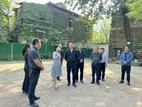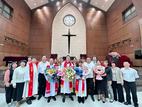Promote the sinicization of Christianity
A worker from Jubilant Grace Church in Lushui County, Nujiang Lisu Autonomous Prefecture, Yunnan, sent me a bible in the Lisu language with his autograph.
I got a free copy of a hymnal in Lisu script in Shaohuiba Church in Tengchong County, Bao, Yunnan.
The Yunnan CCC&TSPM celebrated the 10th anniversary of the Bible translation ministry for ethnic minorities in Kunming Trinity International Church in October 2016.
Lu Yongyao, deputy director of the Ethnic and Religious Affairs Commission of Yunnan Province, addressed in the celebration that the translation and publication of the Bible into minority nationality's languages were two of the important ways to achieve the sinicization of Christianity.
Statistics show that the number of Chinese Christians was just about one million in the early days of communist China, but has skyrocketted to over 23 million today. Such rapid development is rare in the history of Christianity around the world.
The past saw the gradual appearance of the tension between Chinese Christianity and Chinese culture and society.
Popular during the Anti-Christian Movement in the 1920s, the rumors that "Chinese people who believe in the foreign religion are unpatriotic" and "One more Chinese Christian, one fewer Chinese national" revived.
Rev. Cao Shengjie, former president of the CCC, claimed that Christianity needed to be sinicized since its introduction into China and how to be Christians in Chinese society was an inevitable issue for Chinese Christianity.
In August 2016, Christian art performances with Anhui characteristics were given in a forum that explored the theories and practice of the sinicization of Christianity. The programs included Chinese folk song Sweet and Holy Jesus' Name, Huangmei opera opusculum Love Brings Spring Back, Fengyang flower drum opera Praise the Lord with Tambourine and Dances, and an ensemble of flute and erhu, a Chinese two-stringed fiddle.
A week later, on August 12, a symposium on the sinicization of Christianity was held by the Guangzhou CCC&TSPM and Guangzhou Christian Historical and Cultural Center. Experts, scholars, and church staff gathered to discuss the promotion of sinicizing Christianity.
The CCC&TSPM and its subbranches across China conducted symposiums with the theme of the sinicization of Christianity to explore its concept, historical experiences, modern practice, and tasks and objectives as well as approaches to promote it.
The CCC&TSPM implemented the Outline of the Five-year Plan of the CCC&TSPM Theological Construction Preaching Team (2013-2017) .
The Chinese church endeavored to sinicize Christianity in five ways: theological construction, acculturation, church construction, social service, and expression forms of faith.
Witness of light and salt
On January 20, 2015, Xiao Dan (pseudonym), a junior school student living in Daozhen Gelao and Miao Autonomous County of Guizhou, and 12 other children from the same county came to school.
That day four members from a project that cares about basic education, life demands, and spiritual growth of rural orphans played games with them and sent winter clothes and books donated by Chinese netizens to them as new year gifts.
The project was a part of the program "e 10,000 action" officially initiated in 2002 by the Amity Foundation, the largest Christian charitable organization in China. The project is aimed to train children's social skills and stress tolerance through outward bound programs, dream trips, communication, and group games.
Amity, a civil charitable organization sponsored by Chinese Christians, raised 235 million yuan and spent 160 million yuan in 2016. It launches philanthropic projects covering education, social welfare, community development and environmental preservation, and disaster management, which has benefited over tens of millions of Chinese people.
In 2016, the CCC&TSPM proposed to designate the third weekend of October as the charity day in Chinese churches. In its poverty alleviation work in Sandu Shui Autonomous County, Guizhou, the Chinese Christian community regarded the involvement in poverty relief as a major platform to practice faith and live out its values.
Now the Chinese Christian community carries out social welfare and charitable activities covering healthcare, eldercare, childcare, aiding the disabled, poverty reduction, aiding poor students, disaster relief, public facility construction, and environmental care.
The church integrates into society to establish its image
There are over 450,000 Christians in Zhoukou, China's central province of Henan, over 90% of whom live in the countryside.
The church in Zhoukou launched the campaign "three functions" and "three services": "Three functions" means making a church into a "chapel" where Christians worship, a "lecture room" used to spread the legislations and knowledge and also a "classrooms" to train members enriched with practical technology; "three services" refers to developing volunteer preachers into preachers proclaiming the gospel, servants serving the believers, and technicians helping the villagers to cast off poverty and get rich.
Zhoukou's efforts was acclaimed as "a new way to serve society and promote healthy church development".
After the national conference on religious work convened in April 2016, the Chinese church initiated a monthly campaign to learn religious policies and regulations. The CCC&TSPM held special sessions to learn the guiding principles from the national conference and put them into action and local Christian communities planned measures to implement the principles.
Significant effects had been obtained in the construction of the Three-Self Patriotic Movement and personnel training. The administration of religious premises had been more standardized.
The CCC&TSPM disclosed the schemes of the cult "Church of Almighty God" through media outlets and warned local churches to watch against heresies and cults.
In November 2016, the World Council of Churches (WCC) held its executive committee meeting in Shanghai and met church representatives in Nanjing. The executive committee attended services in Nanjing Mochou Lu Church and Nanjing St. Paul's Church and visited the Nanjing Massacre Memorial Hall, Nanjing Union Theological Seminary, and Amity Printing company, the world's largest Bible factory.
In September 2017, a four-person delegation from New Zealand Long Bay Baptist Church visited the Jiangxi CCC&TSPM, Jiangxi Bible School, and churches in Nanchang, the capital of Jiangxi.
On Oct. 16, 2017, Rev. Gary Lundstrom, international vice president for the Billy Graham Evangelistic Association, and the other three workers from the association paid a visit to the CCC&TSPM. Both sides held talks and exchanged ideas on their ministries.
In the previous five years, the Chinese Christian community was active in "going global" and "welcoming" on the basis of independence, equality, mutual respect, and in a friendly manner, participating in international religious conferences and facilitating international cooperation in Bible production and public welfare and charity.
- Translated by Karen Luo
The article was originally posted on China Ethnic Paper with the Chinese name "推进中国化,在相适应道路上取得新进步 ". CCD translated it with permission.













